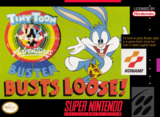Does Buster Fill Bugs' Shoes?
"Buster Busts Loose!" is like most games of this era, an attempt at a 16-bit platform game, complete with items, stomp-able enemies, an offbeat playable character and loads of places to jump around to – nothing new there. You control Buster, and you can jump, slide, flip/kick and power-jump. As an owner of three-heart containers, Buster can take reasonable damage before hitting the deck – of course, in the spirit of Link (bless him!), Buster can upgrade his containers to a total of five.
Visually, this title has a nice appeal. The colour scheme is bright and colourful, as you'd expect, and the sprites themselves are well drawn and varied. Enemies are quite strange actually, and not being a viewer of the cartoon, I can only guess that the vultures, bandits and upright albino-looking guard dogs were regular characters. The environments themselves vary well enough, and they make reasonable use out of their inherit obstacles and distinct compositions. The Wild West stage for example, features self-scrolling train-carriages and a puffing and blowing out-of-control steam engine.
How does the game actually play? Well, from the outset, you notice that Buster is pretty manoeuvrable, even if his single attack method (a sort of back flip and kick combined) does seem a little odd and sometimes useless. He's fast, but he's no Bubsy, (but then Bubsy couldn't run up a vertical wall, could he?) A possessor of a dash-meter, Buster can deplete this to put on a burst of speed. This is useful for making longer jumps and the like.
This title has a few issues in terms of its level-design. I understand that the game may be marketed for a young audience, so this may explain some of the empty, flat areas and unavoidable power-ups. But as you play along, you notice that there is not all that much to do, and that the exploratory content of the game is practically non-existent. This is most noticeable in some of the later areas, where a simple A-to-B-to-C-to-D platform hop is about as complicated as it gets. Also, pickups are few and far between and hardly needed when they are found – almost as if this game play ingredient was included out of obligation.
There are some nice Tiny Toon artistic touches throughout the game, and they feel pretty well married into the game play. The bosses feature regulars from the gang, and there are some pretty neat Bonus Stages (which is the old word for "Mini-game"!) In these, you spin a Mode 7 rendered wheel (inspired by Wheel of Fortune no doubt), to select your mini-game. These vary from average to quite fun. There's a Bingo type game, a pretty nifty squash game, and a strange character weighing game, among others. These little mid-level adventures extend the distressingly short single player game.
Short? Yes. There are only six levels in the game, and sadly, most of them are very brief. This compact level design, coupled with the lack of exploration, gives the game a kind of living-storybook feel - and not in that clever "Paper Mario" style either. Rather, you feel as if you are going through the motions, and the game wants you to experience things at its discretion. This may be a little harsh on a 16-bit effort targeted at children, but I do remember noticing this at the time. Overall, this game has its merits, but it does seem a kind like a lightweight title, as if it was scared of being offensive or too violent. Believe me, it's never approaches anything that a healthy four-year old can't handle.

